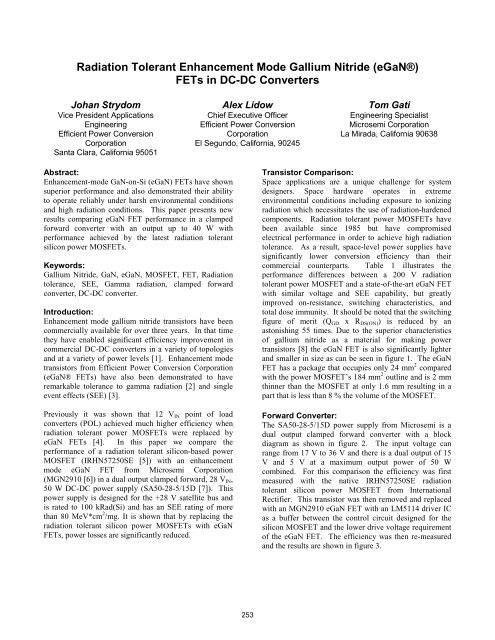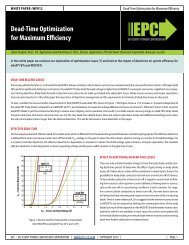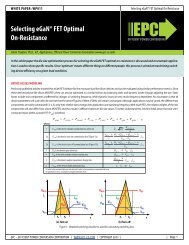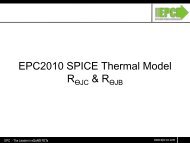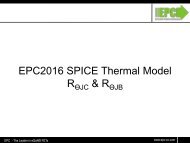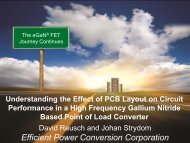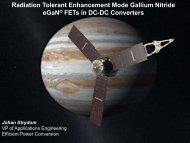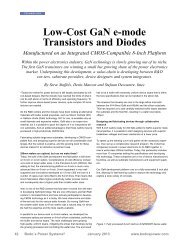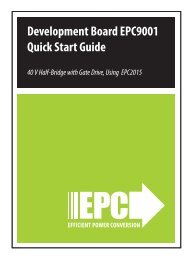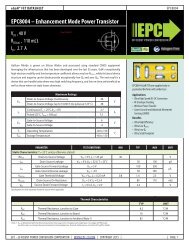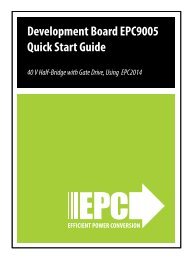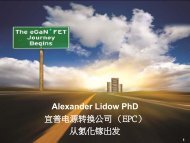Read Paper - EPC
Read Paper - EPC
Read Paper - EPC
Create successful ePaper yourself
Turn your PDF publications into a flip-book with our unique Google optimized e-Paper software.
Radiation Tolerant Enhancement Mode Gallium Nitride (eGaN®)<br />
FETs in DC-DC Converters<br />
Johan Strydom<br />
Vice President Applications<br />
Engineering<br />
Efficient Power Conversion<br />
Corporation<br />
Santa Clara, California 95051<br />
Alex Lidow<br />
Chief Executive Officer<br />
Efficient Power Conversion<br />
Corporation<br />
El Segundo, California, 90245<br />
Tom Gati<br />
Engineering Specialist<br />
Microsemi Corporation<br />
La Mirada, California 90638<br />
Abstract:<br />
Enhancement-mode GaN-on-Si (eGaN) FETs have shown<br />
superior performance and also demonstrated their ability<br />
to operate reliably under harsh environmental conditions<br />
and high radiation conditions. This paper presents new<br />
results comparing eGaN FET performance in a clamped<br />
forward converter with an output up to 40 W with<br />
performance achieved by the latest radiation tolerant<br />
silicon power MOSFETs.<br />
Keywords:<br />
Gallium Nitride, GaN, eGaN, MOSFET, FET, Radiation<br />
tolerance, SEE, Gamma radiation, clamped forward<br />
converter, DC-DC converter.<br />
Introduction:<br />
Enhancement mode gallium nitride transistors have been<br />
commercially available for over three years. In that time<br />
they have enabled significant efficiency improvement in<br />
commercial DC-DC converters in a variety of topologies<br />
and at a variety of power levels [1]. Enhancement mode<br />
transistors from Efficient Power Conversion Corporation<br />
(eGaN® FETs) have also been demonstrated to have<br />
remarkable tolerance to gamma radiation [2] and single<br />
event effects (SEE) [3].<br />
Previously it was shown that 12 V IN point of load<br />
converters (POL) achieved much higher efficiency when<br />
radiation tolerant power MOSFETs were replaced by<br />
eGaN FETs [4]. In this paper we compare the<br />
performance of a radiation tolerant silicon-based power<br />
MOSFET (IRHN57250SE [5]) with an enhancement<br />
mode eGaN FET from Microsemi Corporation<br />
(MGN2910 [6]) in a dual output clamped forward, 28 V IN ,<br />
50 W DC-DC power supply (SA50-28-5/15D [7]). This<br />
power supply is designed for the +28 V satellite bus and<br />
is rated to 100 kRad(Si) and has an SEE rating of more<br />
than 80 MeV*cm 2 /mg. It is shown that by replacing the<br />
radiation tolerant silicon power MOSFETs with eGaN<br />
FETs, power losses are significantly reduced.<br />
Transistor Comparison:<br />
Space applications are a unique challenge for system<br />
designers. Space hardware operates in extreme<br />
environmental conditions including exposure to ionizing<br />
radiation which necessitates the use of radiation-hardened<br />
components. Radiation tolerant power MOSFETs have<br />
been available since 1985 but have compromised<br />
electrical performance in order to achieve high radiation<br />
tolerance. As a result, space-level power supplies have<br />
significantly lower conversion efficiency than their<br />
commercial counterparts. Table 1 illustrates the<br />
performance differences between a 200 V radiation<br />
tolerant power MOSFET and a state-of-the-art eGaN FET<br />
with similar voltage and SEE capability, but greatly<br />
improved on-resistance, switching characteristics, and<br />
total dose immunity. It should be noted that the switching<br />
figure of merit (Q GD x R DS(ON) ) is reduced by an<br />
astonishing 55 times. Due to the superior characteristics<br />
of gallium nitride as a material for making power<br />
transistors [8] the eGaN FET is also significantly lighter<br />
and smaller in size as can be seen in figure 1. The eGaN<br />
FET has a package that occupies only 24 mm 2 compared<br />
with the power MOSFET’s 184 mm 2 outline and is 2 mm<br />
thinner than the MOSFET at only 1.6 mm resulting in a<br />
part that is less than 8 % the volume of the MOSFET.<br />
Forward Converter:<br />
The SA50-28-5/15D power supply from Microsemi is a<br />
dual output clamped forward converter with a block<br />
diagram as shown in figure 2. The input voltage can<br />
range from 17 V to 36 V and there is a dual output of 15<br />
V and 5 V at a maximum output power of 50 W<br />
combined. For this comparison the efficiency was first<br />
measured with the native IRHN57250SE radiation<br />
tolerant silicon power MOSFET from International<br />
Rectifier. This transistor was then removed and replaced<br />
with an MGN2910 eGaN FET with an LM5114 driver IC<br />
as a buffer between the control circuit designed for the<br />
silicon MOSFET and the lower drive voltage requirement<br />
of the eGaN FET. The efficiency was then re-measured<br />
and the results are shown in figure 3.<br />
253
Table 1: Comparison of key electrical and radiation<br />
characteristics between IRHN57250SE and<br />
<strong>EPC</strong>2910<br />
Figure 2: Block diagram of SA50-28-5/15D dual<br />
output clamped forward converter from Microsemi<br />
Corp.<br />
Figure 1: Size comparison between MGN2910<br />
(24mm 2 ) and IRHN57250SE (184 mm 2 ).<br />
The overall system efficiency was improved between<br />
2.5% and 3.5%, but the losses related just to the switching<br />
transistor were reduced by 60% as shown in figure 4.<br />
Figure 5 shows a breakdown of these losses in the two<br />
different transistors at light, medium, and heavy loads.<br />
Judging by the small conduction losses associated with<br />
the eGaN FET and similar output capacitance losses,<br />
designers could reduce cost without degrading efficiency<br />
by using an even smaller eGaN FET such as the<br />
MGN2912. Even though the chosen eGaN FET is a larger<br />
equivalent device with about 40 % the R DS(ON) of the<br />
MOSFET, its switching losses are still about a quarter of<br />
that of the MOSFET. Future eGaN FETs based radiation<br />
tolerant converters can reduce size through increasing the<br />
switching frequency and thus reducing the size of the<br />
magnetic (transformers and inductors) and capacitors,<br />
thus resulting in an even smaller, lighter overall converter.<br />
Figure 3: Efficiency comparison between standard<br />
SA50-28-5/15D dual forward converter with<br />
IRHN57250SE radiation tolerant MOSFET<br />
compared with MGN2910 eGaN FET.<br />
Figure 4: Power losses related to the switching<br />
transistor for eGaN FETs compared with radiation<br />
tolerant MOSFETs.<br />
254
Figure 5: Sources of power losses at 28 V IN at light,<br />
medium, and heavy loads for eGaN FETs compared<br />
with radiation tolerant MOSFETs.<br />
Conclusions:<br />
eGaN FETs have demonstrated their ability to withstand<br />
harsh radiation environments as well as deliver<br />
uncompromised state-of-the-art switching performance in<br />
a space-rated 50 W DC-DC power supply. In addition to<br />
higher power conversion efficiency, the eGaN FETs have<br />
a significantly smaller footprint and, due to their superior<br />
switching characteristics, enable power supplies that<br />
operate at higher frequencies resulting in even further<br />
power density improvements.<br />
References:<br />
[1] Lidow, Strydom, de Rooij, and Ma, “GaN Transistors<br />
for Efficient Power Conversion”, Power Conversion<br />
Publications, 2012.<br />
[2] Alexander Lidow, J. Brandon Witcher, and Ken<br />
Smalley, “Enhancement Mode Gallium Nitride<br />
(eGaN) FET Characteristics under Long Term Stress”,<br />
GOMAC Tech Conference, Orlando, Florida, March<br />
2011.<br />
[3] Alexander Lidow and Ken Smalley, “Radiation<br />
Tolerant Enhancement Mode Gallium Nitride<br />
(eGaN®) FET Characteristics”, GOMAC Tech<br />
Conference, Las Vegas, Nevada, March 2012<br />
[4] Alexander Lidow and Ken Smalley, “The eGaN FET<br />
Journey Continues in Space”, GOMAC Tech 2012<br />
Conference Proceedings, http://epcco.com/epc/documents/presentations/GOMAC%20Te<br />
ch%20Presentation%202012.pdf<br />
[5] IRHN57250SE data sheet, www.irf.com<br />
[6] MGN2910 data sheet, www.microsemi.com<br />
[7] SA50-28 series data sheets,<br />
http://www.microsemi.com/documents/products/SA50<br />
-28-515T.pdf<br />
[8] Sam Davis, “Enhancement Mode Gallium Nitride<br />
MOSFET Delivers Impressive Performance, Power<br />
Electronics Technology, March, 2010,<br />
http://powerelectronics.com/power_semiconductors/p<br />
ower_mosfets/enhancement-mode-gallium-nitride-<br />
032010/<br />
255


